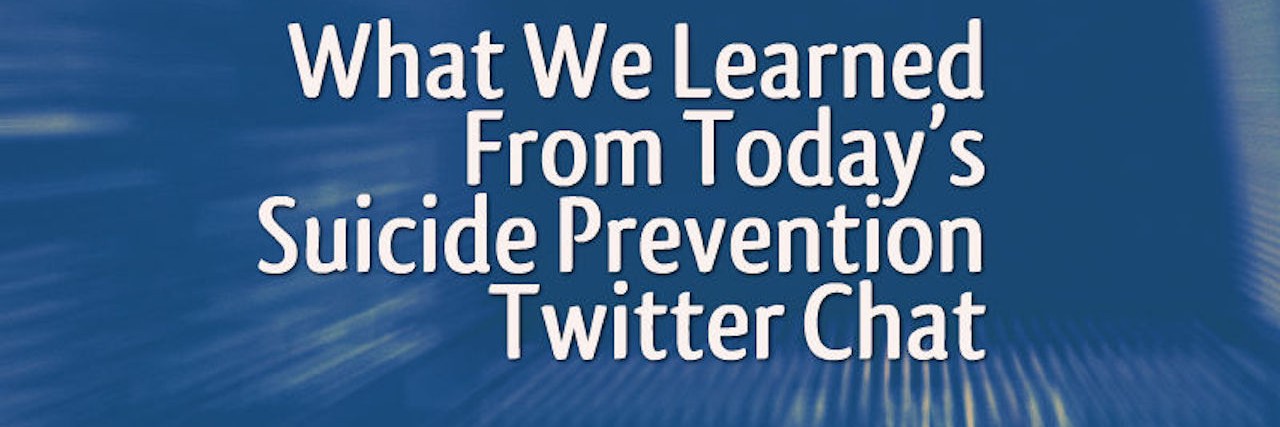On Tuesday, Twitter refused to be quiet about suicide. In honor of National Suicide Prevention Week, mental health advocates and organizations — including Mental Health America and American Foundation for Suicide Prevention — joined Stamp Out Stigma in a Twitter chat, covering topics like the warning signs of suicide and how the media should report on suicide.
In case you missed it, here are some important lessons we learned:
On the warning signs of suicide:
A1. Warning signs: When someone talks abt killing themselves, being a burden, feeling trapped, unbearable pain, etc #soschat
— American Foundation for Suicide Prevention (@afspnational) September 8, 2015
A1: Giving away a lot of things, especially important things or things they usually have a strong attachment to. #SOSchat
— Maya Northen Augelli (@mayanorthen) September 8, 2015
A1: sometimes the signs are subtle: behavior change rapidly, they act callously/give away belongings, seem distant/strangly calm #soschat
— Matt Goldenberg D.O. (@docgoldenberg) September 8, 2015
A1 #SOSChat erasing social media presence is a sign.
— The Campbell Center (@idamaecampbell) September 8, 2015
On starting the conversation with someone who exhibits these warning signs:
A2. Asking someone about suicide, doesn't make them suicidal. It helps start the conversation. #soschat
— American Foundation for Suicide Prevention (@afspnational) September 8, 2015
A2 Sometimes it's best just to listen. Validate feelings. No such thing as "wrong" feeling. #soschat
— NAMI Queens/Nassau (@NAMI_QN) September 8, 2015
A2: Take them seriously. I've had ppl accuse me of trying to get attention when I say I'm feeling like life isn't worth it. #SOSchat
— Maya Northen Augelli (@mayanorthen) September 8, 2015
A2 Be yourself. LISTEN. Be non-judgmental. Saying something like, "How can I best support you right now?" can do a lot of good #soschat
— The Bella Vita (@TheBellaVita) September 8, 2015
On ways you can help someone who’s talking about suicide:
A3 Reach out and let them know it's OK to talk about how and why they're feeling suicidal and help is available. Remove the taboo. #SOSchat
— Paul's Letters (@paulslttrs) September 8, 2015
A3. For young people, get in touch with a trusted adult with or without your friend, and tell them what's going on. #soschat
— American Foundation for Suicide Prevention (@afspnational) September 8, 2015
A3: don't try to handle the situation on your own. You can be helpful by referring him/her to professionals (counselor, therapist) #SOSChat
— SAE & Associates (@SAE_Associates) September 8, 2015
A3: Ask them if there's anything you can do to help them feel safe. Offer to stay with them until they're feeling more grounded. #SOSchat
— Silver Hill Hospital (@SilverHillHosp) September 8, 2015
On the best way for the media and the general public to talk and write about suicide:
A4: Never use "successful" to refer to someone who died by suicide or "failed" for someone that survived an attempt! #SOSChat
— AFSP South NJ (@AFSPSouthJersey) September 8, 2015
A4. People DIE BY suicide. We don't say "commit" because it is not a crime. #soschat
— American Foundation for Suicide Prevention (@afspnational) September 8, 2015
A4 Important to attribute suicide to real causes like depression instead of metaphors like "so-and-so struggled with some demons" #SOSchat
— Paul's Letters (@paulslttrs) September 8, 2015
A4. By doing what we are doing now. Raising awareness, talking about it openly, and always providing resources. #soschat
— ADAA (@Got_Anxiety) September 8, 2015
On how can schools and communities work together to prevent suicide:
A5: By educating our teachers, parents, and the students themselves. The more information they have, the better. #SOSChat
— Silver Hill Hospital (@SilverHillHosp) September 8, 2015
A5 by having awareness events & student organizations dedicated to these. They show someone in need that there's someone who cares #SOSchat
— Ana María (@annieemo_) September 8, 2015
A5: provide support and training for guidance councilors and school social workers @afspnational #SOSChat
— Michael Stroh (@StartsWithMe_) September 8, 2015
A5 Eliminate the shame that many associate with their mental health. Allow them to feel warranted in their suffering #soschat
— The Bella Vita (@TheBellaVita) September 8, 2015
On resources that could help educate people about suicide prevention:
A6 Support groups are great for everyone. Surviors, family and friends #soschat
— The Bella Vita (@TheBellaVita) September 8, 2015
One of the keys to #suicideprevention is education. I try and share my story and experience to let people know it's OK to talk. #SOSchat
— Paul's Letters (@paulslttrs) September 8, 2015
The National Suicide Prevention Lifeline is a great resource: @800273TALK http://t.co/kj8oBnsGmQ #B4Stage4 #soschat
— Mental Health America (@MentalHealthAm) September 8, 2015
Thanks to everyone who’s speaking up — let’s keep the conversation going.
Related: 7 Easy but Important Ways to Participate in National Suicide Prevention Week
If you or someone you know needs help, see our suicide prevention resources.
If you need support right now, call the Suicide Prevention Lifeline at 1-800-273-8255.

